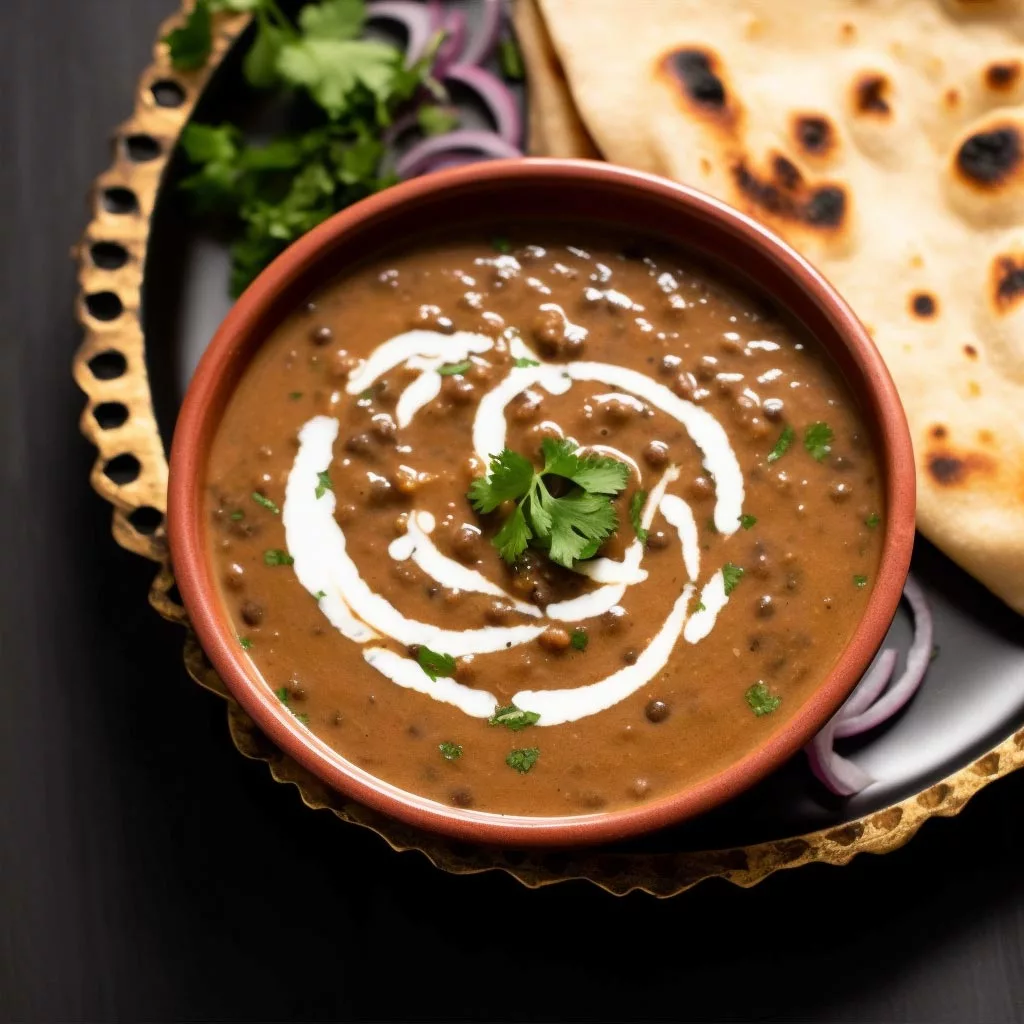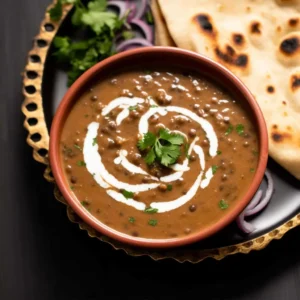
Dal Makhani, a rich and creamy lentil dish, holds its roots deep in the heart of North Indian cuisine. With its velvety texture and aromatic spices, it’s a dish that has been cherished for generations. While it might sound fancy, fear not, for its preparation is simpler than you might imagine.
This dish features whole black lentils and kidney beans, soaked overnight to tenderize them before cooking. The lentils and beans are then pressure-cooked until they reach a melt-in-your-mouth consistency.
Meanwhile, a medley of spices including cumin, coriander, turmeric, and garam masala infuse the dish with layers of flavor.
To start, we sauté finely chopped onions until they turn golden brown, infusing the dish with a sweet and savory depth. Ginger and garlic paste add a punch of aromatic intensity, while tomatoes and green chilies lend a subtle tanginess and heat.
Once the lentils and beans are cooked to perfection, they’re combined with the flavorful onion-tomato base, simmered gently until all the ingredients meld together beautifully. A touch of double cream adds richness and indulgence, elevating this dish to new heights.
Garnished with fresh coriander leaves, this Dal Makhani is ready to grace your table, whether alongside fluffy rice or warm naan bread.
Expert Tip: For added depth of flavor, toast the whole spices (cumin seeds, coriander seeds) before grinding them into powder for the recipe. This releases their essential oils and enhances their aroma.
Lentils Whole Black: Black lentils bring a hearty texture and earthy flavor to Dal Makhani. When cooked, they become creamy and satisfying, adding depth to the dish.
Kidney Beans (Rajma): Kidney beans complement the lentils, providing a contrasting texture and nutty taste. They add substance to the dish, making it more filling and nutritious.
Ghee (Butter): Ghee, or clarified butter, imparts a rich and buttery flavor to the dish. It enhances the overall taste and aroma, giving Dal Makhani its signature indulgent character.
Onions: Finely chopped onions form the flavor base of Dal Makhani, providing sweetness and depth. When sautéed until golden brown, they add complexity to the dish.
Ginger Paste: Ginger paste adds a warm and spicy kick to the dish, balancing out the richness of the other ingredients. It contributes to the aromatic profile of Dal Makhani.
Garlic Paste: Garlic paste enhances the savory notes of the dish, infusing it with a pungent and aromatic flavor. It complements the other spices and ingredients, creating a harmonious blend of flavors.
Tomatoes: Finely chopped tomatoes lend a tangy and slightly sweet flavor to Dal Makhani. They help create a flavorful base for the dish and add a hint of freshness.
Green Chilies: Finely chopped green chilies provide a subtle heat and brightness to the dish. They add a spicy kick without overpowering the other flavors.
Salt: Salt enhances the flavors of all the other ingredients, balancing out the sweetness, acidity, and spiciness. It is essential for seasoning the dish to perfection.
Cumin Powder: Cumin powder adds a warm and earthy flavor to Dal Makhani. It complements the other spices and lends depth to the dish.
Coriander Powder: Coriander powder contributes a citrusy and floral aroma to the dish, enhancing its overall flavor profile. It pairs well with the other spices, adding complexity.
Turmeric Powder: Turmeric powder provides a vibrant yellow color to Dal Makhani and adds a subtle earthy flavor. It also offers numerous health benefits due to its anti-inflammatory properties.
Chili Powder: Chili powder adds heat and spiciness to the dish, giving it a bold and robust flavor. Adjust the amount according to your preference for spice level.
Garam Masala: Garam masala is a blend of aromatic spices that adds warmth and depth to Dal Makhani. It ties together all the flavors and elevates the dish to a new level of deliciousness.
Double Cream: Double cream adds richness and creaminess to Dal Makhani, giving it a luxurious texture. It balances out the spices and adds a velvety smoothness to the dish.
Coriander: Fresh coriander leaves, also known as cilantro, are used as a garnish for Dal Makhani. They add a pop of color and freshness, enhancing the visual appeal of the dish while adding a hint of herbal flavor.
Expert Tip: Adjust the spice levels according to your taste preferences. If you prefer a milder dish, reduce the amount of chili powder and green chilies.
Expert Tip: Soaking the lentils and kidney beans overnight helps to soften them, reducing the cooking time and ensuring they become tender.
Yes, you can substitute canned lentils and kidney beans for the dried ones. Just make sure to rinse them thoroughly before using.
Absolutely! Feel free to adjust the amount of green chilies and chili powder according to your preference for heat.
Yes, you can prepare the Korean fried chicken in advance and reheat it before serving. Just store it in an airtight container in the refrigerator for up to 2 days.
Yes, you can freeze the leftovers in an airtight container for up to 3 months. Thaw overnight in the refrigerator before reheating.
While the double cream adds richness to the dish, you can omit it if you prefer a lighter version. Alternatively, you can substitute it with coconut cream for a dairy-free option.
Here are some more recipes for you to enjoy! If you my recipes don’t forget to rate and leave a comment.
If you have any recipe suggestions, please do not hesitate to ask me. A great way to stay in contact with me is through Instagram, Facebook, Twitter and YouTube. Don’t forget to tag me @CookwithNabeela in your recipe photos!

Subscribe now to receive my latest recipes directly in your inbox. Stay up-to-date and never miss out!

I love to cook! I want to share with you my favourite, delicious family-friendly recipes. I want to inspire you to create fantastic food for your family every day.
Add your first comment to this post